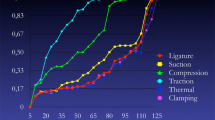Abstract
Purpose
The mechanism of left recurrent laryngeal nerve palsy after cervical mediastinoscopy remains unclear. Our aim is to describe the anatomical bases of this complication.
Methods
Video-assisted mediastinoscopy was performed on ten fresh human cadavers with simultaneous dissection of the left recurrent nerve.
Results
Three dissection areas could be described regarding the risk of left recurrent nerve damage: a low risk area, along the right wall and before the upper part of the anterior wall of the trachea; an area at high risk of indirect stretch-induced lesions, between the lower part of the anterior wall of the trachea and the aorta; -an area at high risk of direct injury, against the lower part of the left wall of the trachea.
Conclusions
Dissection between the trachea and the aorta causes traction on the left recurrent nerve. Indirect stretch-induced injury is probably a frequent mechanism of left recurrent nerve palsy during mediastinoscopy.



Similar content being viewed by others
References
Carlens E (1959) Mediastinoscopy: a method for inspection and tissue biopsy in the superior mediastinum. Dis Chest 36:343–352
Coughlin M, Deslauriers J, Beaulieu M et al (1985) Role of mediastinoscopy in pretreatment staging of patients with primary lung cancer. Ann Thorac Surg 40:556–560
Detterbeck FC, Jantz MA, Wallace M et al (2007) Invasive mediastinal staging of lung cancer: ACCP evidence-based clinical practice guidelines (2nd edition). Chest 132:202S–220S
Ellis PD, Pallister WK (1975) Recurrent laryngeal nerve palsy and endotracheal intubation. J Laryngol Otol 89:823–826
Filaire M, Garcier JM, Harouna Y et al (2001) Intrathoracic blood supply of the left vagus and recurrent laryngeal nerves. Surg Radiol Anat 23:249–252
Le Pimpec Barthes F, D’Attellis N, Assouad J et al (2003) Chylous leak after cervical mediastinoscopy. J Thorac Cardiovasc Surg 126:1199–1200
Lemaire A, Nikolic I, Petersen T et al (2006) Nine-year single center experience with cervical mediastinoscopy: complications and false negative rate. Ann Thorac Surg 82:1185–1189
Leschber G, Sperling D, Klemm W et al (2008) Does video-mediastinoscopy improve the results of conventional mediastinoscopy? Eur J Cardiothorac Surg 33:289–293
Mountain CF, Dresler CM (1997) Regional lymph node classification for lung cancer staging. Chest 111:1718–1723
Riquet M (1993) Anatomic basis of lymphatic spread from carcinoma of the lung to the mediastinum: surgical and prognostic implications. Surg Radiol Anat 15:271–277
Riquet M, Manac’h D, Dupont P et al (1994) Anatomic basis of lymphatic spread of lung carcinoma to the mediastinum: anatomo-clinical correlations. Surg Radiol Anat 16:229–238
Roberts JR, Wadsworth J (2007) Recurrent laryngeal nerve monitoring during mediastinoscopy: predictors of injury. Ann Thorac Surg 83:388–391
Sortini A, Navarra G, Santini M et al (1994) Video-assisted mediastinoscopy. A new application of television technology in surgery. Minerva Chir 49:803–805
Venissac N, Alifano M, Mouroux J (2003) Video-assisted mediastinoscopy: experience from 240 consecutive cases. Ann Thorac Surg 76:208–212
Weisberg NK, Spengler DM, Netterville JL (1997) Stretch-induced nerve injury as a cause of paralysis secondary to the anterior cervical approach. Otolaryngol Head Neck Surg 116:317–326
Widstrom A (1975) Palsy of the recurrent nerve following mediastinoscopy. Chest 67:365–366
Witte B, Wolf M, Huertgen M et al (2006) Video-assisted mediastinoscopic surgery: clinical feasibility and accuracy of mediastinal lymph node staging. Ann Thorac Surg 82:1821–1827
Acknowledgments
The author thank Miss Tracy Chapman for kindly reviewing the manuscript, Mrs. Marie José Fouque for picture management, Mrs. Chamaillard and Mr. De Livron from Karl Storz Company for technical support, and Mr. Philippe Peugeot and Mr. Hubert for technical help.
Conflict of interest statement
The authors declare that they have no conflict of interest.
Author information
Authors and Affiliations
Corresponding author
Rights and permissions
About this article
Cite this article
Benouaich, V., Marcheix, B., Carfagna, L. et al. Anatomical bases of left recurrent nerve lesions during mediastinoscopy. Surg Radiol Anat 31, 295–299 (2009). https://doi.org/10.1007/s00276-008-0451-1
Received:
Accepted:
Published:
Issue Date:
DOI: https://doi.org/10.1007/s00276-008-0451-1




